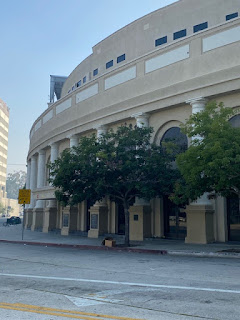Week 210: Echo Park / Angelino Heights
July 05, 202010,000 Steps a Day in L.A. #5, Echoes of Decades Past, 3.2 miles
To avoid crowded parks and trails, Barbara and I social distanced back to the past for a notorious, definitive, curious, fresh, and classic history-laden hike through the streets of Echo Park. We started at the corner of Park Ave. and Glendale Blvd. where Aimee Semple McPherson's Angelus Temple, a National Historic Landmark, stands as the first megachurch constructed in the U.S. Built in 1923, the popularity of Aimee's three daily sermons to capacity crowds made her one of the biggest celebs in Hollywood through the 20s and 30s. So much so, that Johnny Mercer put Aimee in the lyrics of his 1937 song, "Hooray for Hollywood." We headed south on Glendale along Echo Park Lake, the 1868 man-made reservoir turned city park in 1892, one of the oldest parks in Los Angeles. Continuing south, Glendale Blvd. itself has a noteworthy history: in the 1890s, Edward L. Doheny discovered oil near the corner of Glendale and 2nd St. and started a "second black gold rush" that lasted for a few years. Nearby on 2nd, a sign with a red streetcar on the modern residential building at 1304 2nd Street, reads "Belmont Station Apartment Homes," marking the site of the tunnel entrance to 1925's one-mile "Hollywood Subway" that, at its peak, carried 65,000 passengers daily from Echo Park to the Subway Terminal Building in DTLA until it closed down in the 1950s. A turn north on Toluca Street led us to the first new park in DTLA in over a hundred years—the completely charming Vista Hermosa Park maintained by the Santa Monica Mountains Conservancy. With eco-friendly, winding paths, Vista Hermosa is a fresh air oasis with amazing views of DTLA. We exited the park at the Colton Street gate and made our way to Temple Street. Everyone is familiar with Temple Street, but the nondescript section we walked today was buzzing from 1886 to 1902 as L.A.'s first cable car line delivered passengers all the way to Main Street downtown. Remember, no cars yet! We left Temple at Edgeware Rd. and crossed over the Hollywood Fwy. into Angelino Heights. Founded in 1886 during the land boom of the mid-1880s, Angelino Heights is L.A.'s second oldest district outside DTLA, our first true suburb, and the first recognized Historic District in the city. Its most famous street, Carroll Avenue, is on the National Register of Historic Districts for good reason—at least thirteen of the houses on Carroll are individual Los Angeles Historic-Cultural Landmarks, Victorians and Queen Annes truly worth seeing in person. Drenched in the past, Barbara and I found our way back to Echo Park Lake where the lotus blossoms are in bloom—a curiosity because no one quite knows who planted them over a hundred years ago. If you like L.A. history, this hike is an up close education and treat.



















0 comments